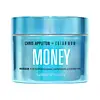What's inside
What's inside
 Key Ingredients
Key Ingredients

 Benefits
Benefits

 Concerns
Concerns

 Ingredients Side-by-side
Ingredients Side-by-side

Water
Skin ConditioningCetearyl Alcohol
EmollientGlycine Soja Oil
EmollientLactobacillus
Skin ConditioningGlycerin
HumectantHydrolyzed Rice Protein
Skin ConditioningHippophae Rhamnoides Fruit Oil
Skin ProtectingCetrimonium Chloride
AntimicrobialPotassium Palmitoyl Hydrolyzed Wheat Protein
CleansingAdansonia Digitata Seed Oil
EmollientMoringa Oleifera Seed Oil
EmollientNigella Sativa Seed Oil
EmollientOlea Europaea Fruit Oil
MaskingSqualane
EmollientCitrullus Lanatus Seed Oil
EmollientArgania Spinosa Kernel Oil
EmollientHelianthus Annuus Seed Extract
Skin ConditioningOryza Sativa Bran Oil
EmollientPolyquaternium-10
Behentrimonium Methosulfate
C9-12 Alkane
SolventStearalkonium Chloride
PreservativeHydroxyethylcellulose
Emulsion StabilisingPhytic Acid
Citric Acid
BufferingCoco-Caprylate/Caprate
EmollientCI 77491
Cosmetic ColorantCI 77891
Cosmetic ColorantCaramel
Cosmetic ColorantMica
Cosmetic ColorantParfum
MaskingPotassium Sorbate
PreservativePhenoxyethanol
PreservativeSodium Acetate
BufferingCellulose
AbsorbentSodium Benzoate
MaskingLinalool
PerfumingWater, Cetearyl Alcohol, Glycine Soja Oil, Lactobacillus, Glycerin, Hydrolyzed Rice Protein, Hippophae Rhamnoides Fruit Oil, Cetrimonium Chloride, Potassium Palmitoyl Hydrolyzed Wheat Protein, Adansonia Digitata Seed Oil, Moringa Oleifera Seed Oil, Nigella Sativa Seed Oil, Olea Europaea Fruit Oil, Squalane, Citrullus Lanatus Seed Oil, Argania Spinosa Kernel Oil, Helianthus Annuus Seed Extract, Oryza Sativa Bran Oil, Polyquaternium-10, Behentrimonium Methosulfate, C9-12 Alkane, Stearalkonium Chloride, Hydroxyethylcellulose, Phytic Acid, Citric Acid, Coco-Caprylate/Caprate, CI 77491, CI 77891, Caramel, Mica, Parfum, Potassium Sorbate, Phenoxyethanol, Sodium Acetate, Cellulose, Sodium Benzoate, Linalool
Water
Skin ConditioningStearyl Alcohol
EmollientDimethicone
EmollientCetyl Alcohol
EmollientStearamidopropyl Dimethylamine
EmulsifyingButylene Glycol
HumectantDicetyldimonium Chloride
EmulsifyingBehentrimonium Chloride
PreservativePropanediol
SolventHydrolyzed Vegetable Protein Pg-Propyl Silanetriol
Skin ConditioningCitric Acid
BufferingChlorella Pyrenoidosa Extract
Skin ConditioningChondrus Crispus Extract
Skin ConditioningUndaria Pinnatifida Extract
Skin ConditioningLaminaria Saccharina Extract
Skin ProtectingCeteareth-20
CleansingDimethiconol
EmollientPhenoxyethanol
PreservativePPG-26-Buteth-26
Skin ConditioningApigenin
AntioxidantOleanolic Acid
Skin ConditioningBiotinoyl Tripeptide-1
Crambe Maritima Leaf Extract
Skin ConditioningParfum
MaskingChlorphenesin
AntimicrobialPEG-40 Hydrogenated Castor Oil
EmulsifyingIsopropyl Alcohol
SolventCaprylyl Glycol
EmollientPropylene Glycol
HumectantPotassium Benzoate
PreservativePotassium Sorbate
PreservativeDisodium EDTA
Benzyl Salicylate
PerfumingAlpha-Isomethyl Ionone
PerfumingCI 42090
Cosmetic ColorantCI 60730
Cosmetic ColorantWater, Stearyl Alcohol, Dimethicone, Cetyl Alcohol, Stearamidopropyl Dimethylamine, Butylene Glycol, Dicetyldimonium Chloride, Behentrimonium Chloride, Propanediol, Hydrolyzed Vegetable Protein Pg-Propyl Silanetriol, Citric Acid, Chlorella Pyrenoidosa Extract, Chondrus Crispus Extract, Undaria Pinnatifida Extract, Laminaria Saccharina Extract, Ceteareth-20, Dimethiconol, Phenoxyethanol, PPG-26-Buteth-26, Apigenin, Oleanolic Acid, Biotinoyl Tripeptide-1, Crambe Maritima Leaf Extract, Parfum, Chlorphenesin, PEG-40 Hydrogenated Castor Oil, Isopropyl Alcohol, Caprylyl Glycol, Propylene Glycol, Potassium Benzoate, Potassium Sorbate, Disodium EDTA, Benzyl Salicylate, Alpha-Isomethyl Ionone, CI 42090, CI 60730
Ingredients Explained
These ingredients are found in both products.
Ingredients higher up in an ingredient list are typically present in a larger amount.
Citric Acid is an alpha hydroxy acid (AHA) naturally found in citrus fruits like oranges, lemons, and limes.
Like other AHAs, citric acid can exfoliate skin by breaking down the bonds that hold dead skin cells together. This helps reveal smoother and brighter skin underneath.
However, this exfoliating effect only happens at high concentrations (20%) which can be hard to find in cosmetic products.
Due to this, citric acid is usually included in small amounts as a pH adjuster. This helps keep products slightly more acidic and compatible with skin's natural pH.
In skincare formulas, citric acid can:
While it can provide some skin benefits, research shows lactic acid and glycolic acid are generally more effective and less irritating exfoliants.
Most citric acid used in skincare today is made by fermenting sugars (usually from molasses). This synthetic version is identical to the natural citrus form but easier to stabilize and use in formulations.
Read more about some other popular AHA's here:
Learn more about Citric AcidParfum is a catch-all term for an ingredient or more that is used to give a scent to products.
Also called "fragrance", this ingredient can be a blend of hundreds of chemicals or plant oils. This means every product with "fragrance" or "parfum" in the ingredients list is a different mixture.
For instance, Habanolide is a proprietary trade name for a specific aroma chemical. When used as a fragrance ingredient in cosmetics, most aroma chemicals fall under the broad labeling category of “FRAGRANCE” or “PARFUM” according to EU and US regulations.
The term 'parfum' or 'fragrance' is not regulated in many countries. In many cases, it is up to the brand to define this term.
For instance, many brands choose to label themselves as "fragrance-free" because they are not using synthetic fragrances. However, their products may still contain ingredients such as essential oils that are considered a fragrance by INCI standards.
One example is Calendula flower extract. Calendula is an essential oil that still imparts a scent or 'fragrance'.
Depending on the blend, the ingredients in the mixture can cause allergies and sensitivities on the skin. Some ingredients that are known EU allergens include linalool and citronellol.
Parfum can also be used to mask or cover an unpleasant scent.
The bottom line is: not all fragrances/parfum/ingredients are created equally. If you are worried about fragrances, we recommend taking a closer look at an ingredient. And of course, we always recommend speaking with a professional.
Learn more about ParfumPhenoxyethanol is a preservative that has germicide, antimicrobial, and aromatic properties. Studies show that phenoxyethanol can prevent microbial growth. By itself, it has a scent that is similar to that of a rose.
It's often used in formulations along with Caprylyl Glycol to preserve the shelf life of products.
Potassium Sorbate is a preservative used to prevent yeast and mold in products. It is commonly found in both cosmetic and food products.
This ingredient comes from potassium salt derived from sorbic acid. Sorbic acid is a natural antibiotic and effective against fungus.
Both potassium sorbate and sorbic acid can be found in baked goods, cheeses, dried meats, dried fruit, ice cream, pickles, wine, yogurt, and more.
You'll often find this ingredient used with other preservatives.
Learn more about Potassium SorbateWater. It's the most common cosmetic ingredient of all. You'll usually see it at the top of ingredient lists, meaning that it makes up the largest part of the product.
So why is it so popular? Water most often acts as a solvent - this means that it helps dissolve other ingredients into the formulation.
You'll also recognize water as that liquid we all need to stay alive. If you see this, drink a glass of water. Stay hydrated!
Learn more about Water